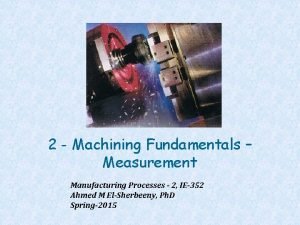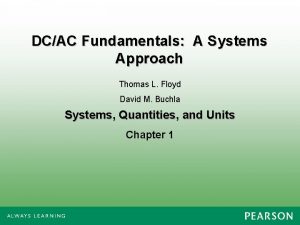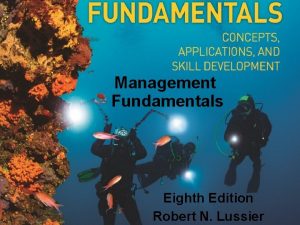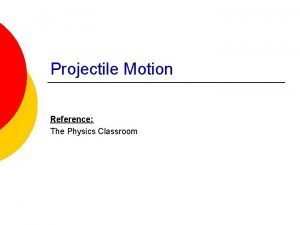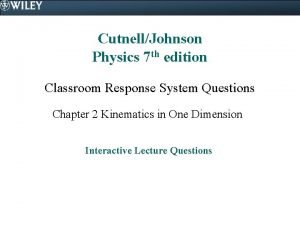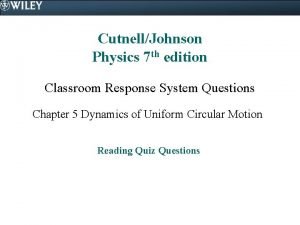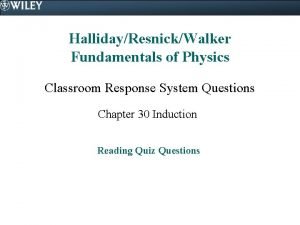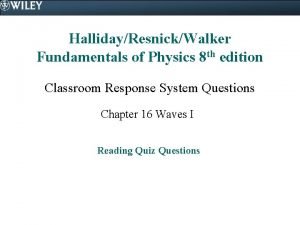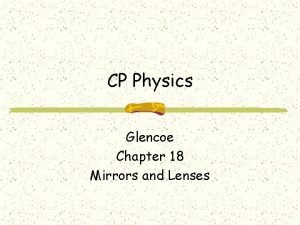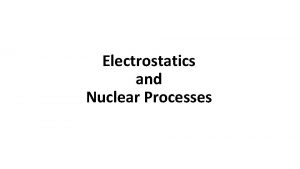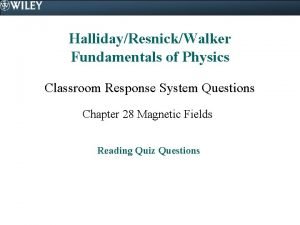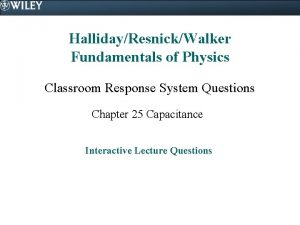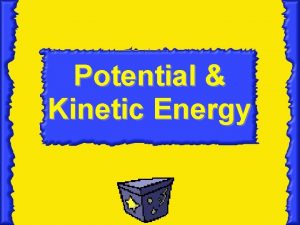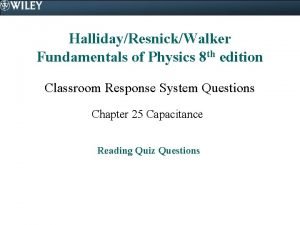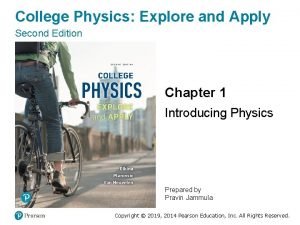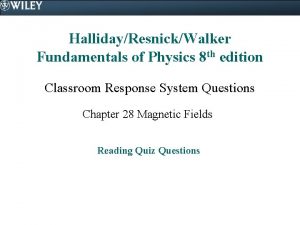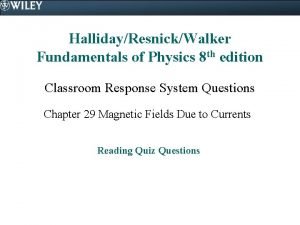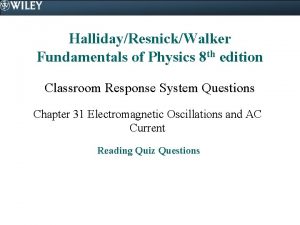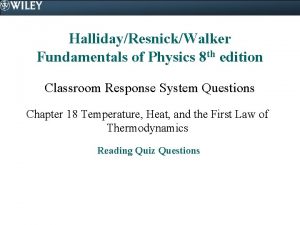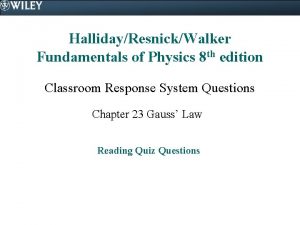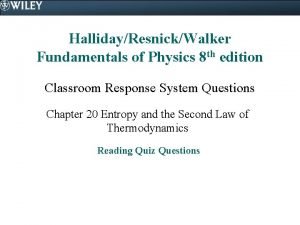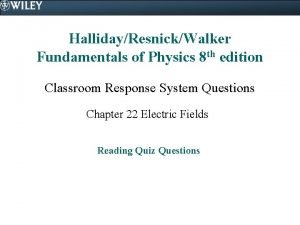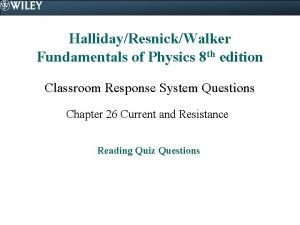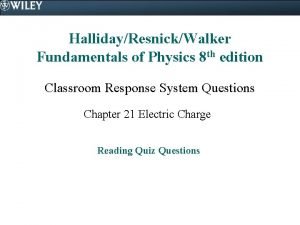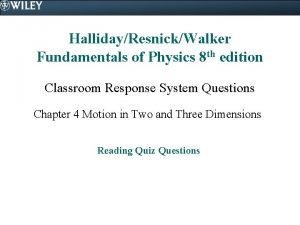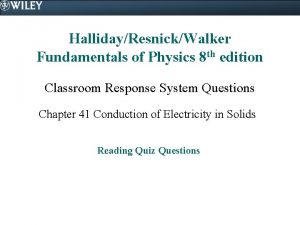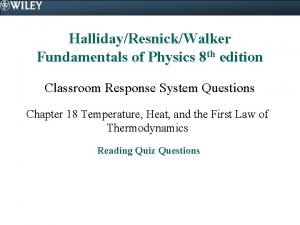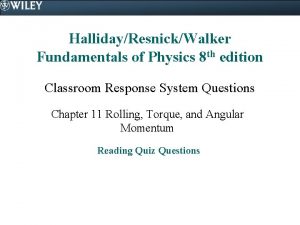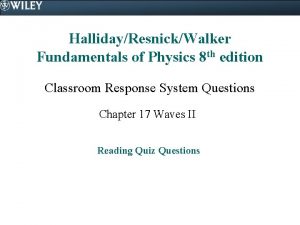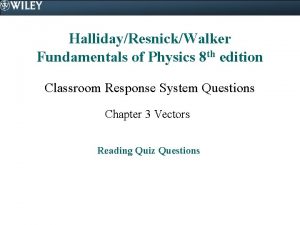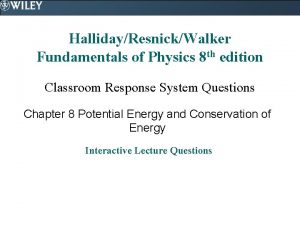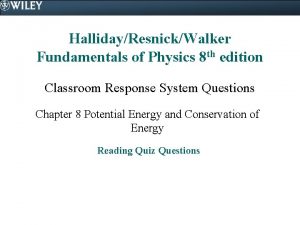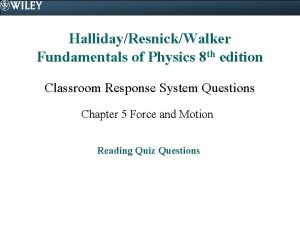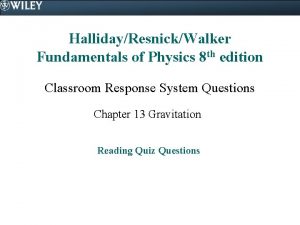HallidayResnickWalker Fundamentals of Physics 8 th edition Classroom











































- Slides: 43

Halliday/Resnick/Walker Fundamentals of Physics 8 th edition Classroom Response System Questions Chapter 1 Measurement Reading Quiz Questions

1. 1. 1. According to the text, on what are science and engineering based? a) knowledge and intuition b) meter sticks and accurate time pieces c) measurements and comparison d) hypotheses and theories e) vision and perseverance

1. 1. 1. According to the text, on what are science and engineering based? a) knowledge and intuition b) meter sticks and accurate time pieces c) measurements and comparison d) hypotheses and theories e) vision and perseverance

1. 2. 1. Complete the following statement: The standard meter is defined in terms of the speed of light because a) all scientists have access to sunlight. b) no agreement could be reached on a standard meter stick. c) the yard is defined in terms of the speed of sound in air. d) the normal meter is defined with respect to the circumference of the earth. e) it is a universal constant.

1. 2. 1. Complete the following statement: The standard meter is defined in terms of the speed of light because a) all scientists have access to sunlight. b) no agreement could be reached on a standard meter stick. c) the yard is defined in terms of the speed of sound in air. d) the normal meter is defined with respect to the circumference of the earth. e) it is a universal constant.

1. 3. 1. The text uses SI units, such as the meter or the kilogram. Which one of the following phrases is the best translation for the French phrase for which “SI” is the abbreviation? a) International System of Units b) Institute of Science Standards c) Institute for Systems Integration d) Systematic Information e) Science and Engineering Standards

1. 3. 1. The text uses SI units, such as the meter or the kilogram. Which one of the following phrases is the best translation for the French phrase for which “SI” is the abbreviation? a) International System of Units b) Institute of Science Standards c) Institute for Systems Integration d) Systematic Information e) Science and Engineering Standards

1. 3. 2. Which of the following units is not an SI base unit? a) second b) meter c) kilogram d) slug

1. 3. 2. Which of the following units is not an SI base unit? a) second b) meter c) kilogram d) slug

1. 3. 3. In the International System of Units, mass is measured using which of the following units? a) grams b) kilograms c) pounds d) newtons e) slugs

1. 3. 3. In the International System of Units, mass is measured using which of the following units? a) grams b) kilograms c) pounds d) newtons e) slugs

1. 3. 4. In the International System of Units, length is measured using which of the following units? a) inches b) feet c) meters d) centimeters e) kilometers

1. 3. 4. In the International System of Units, length is measured using which of the following units? a) inches b) feet c) meters d) centimeters e) kilometers

1. 3. 5. Express 0. 00592 in scientific notation. a) 5. 92 × 103 b) 5. 92 × 10 3 c) 5. 92 × 10 2 d) 5. 92 × 10 5 e) 5. 92 × 105

1. 3. 5. Express 0. 00592 in scientific notation. a) 5. 92 × 103 b) 5. 92 × 10 3 c) 5. 92 × 10 2 d) 5. 92 × 10 5 e) 5. 92 × 105

1. 3. 6. The ratio a) 10+3 b) 10 3 c) 10 6 d) 10+6 e) 100 equals

1. 3. 6. The ratio a) 10+3 b) 10 3 c) 10 6 d) 10+6 e) 100 equals

1. 4. 1. The energy content of food is reported in Calories, where 1 Calorie = 1000 kilocalories and 1 kilocalorie = 4186 J. How many joules are in a drink that contains 140 Calories? a) 33 joules b) 590 joules c) 5. 9 × 108 joules d) 4. 2 × 106 joules e) 1. 4 × 105 joules

1. 4. 1. The energy content of food is reported in Calories, where 1 Calorie = 1000 kilocalories and 1 kilocalorie = 4186 J. How many joules are in a drink that contains 140 Calories? a) 33 joules b) 590 joules c) 5. 9 × 108 joules d) 4. 2 × 106 joules e) 1. 4 × 105 joules

1. 4. 2. Which one of the following statements concerning unit conversion is false? a) Units can be treated as algebraic quantities. b) Units have no numerical significance, so 1. 00 kilogram = 1. 00 slug. c) Unit conversion factors are given inside the front cover of the text. d) The fact that multiplying an equation by a factor of 1 does not change an equation is important in unit conversion. e) Only quantities with the same units can be added or subtracted.

1. 4. 2. Which one of the following statements concerning unit conversion is false? a) Units can be treated as algebraic quantities. b) Units have no numerical significance, so 1. 00 kilogram = 1. 00 slug. c) Unit conversion factors are given inside the front cover of the text. d) The fact that multiplying an equation by a factor of 1 does not change an equation is important in unit conversion. e) Only quantities with the same units can be added or subtracted.

1. 4. 3. Which one of the following pairs of units may not be added together, even after the appropriate unit conversions have been made? a) feet and centimeters b) seconds and slugs c) meters and miles d) grams and kilograms e) hours and years

1. 4. 3. Which one of the following pairs of units may not be added together, even after the appropriate unit conversions have been made? a) feet and centimeters b) seconds and slugs c) meters and miles d) grams and kilograms e) hours and years

1. 4. 4. How many meters are there in 12. 5 kilometers? a) 1. 25 b) 125 c) 1250 d) 12 500 e) 125 000

1. 4. 4. How many meters are there in 12. 5 kilometers? a) 1. 25 b) 125 c) 1250 d) 12 500 e) 125 000

1. 4. 5 Express the quantity 12. 5 meters in kilometers? a) 0. 0125 km b) 0. 125 km c) 1. 25 km d) 12. 5 km e) 125 km

1. 4. 5 Express the quantity 12. 5 meters in kilometers? a) 0. 0125 km b) 0. 125 km c) 1. 25 km d) 12. 5 km e) 125 km

1. 4. 6 If one inch is equal to 2. 54 cm, express 9. 68 inches in meters. a) 0. 262 m b) 0. 0381 m c) 0. 0508 m d) 0. 114 m e) 0. 246 m

1. 4. 6 If one inch is equal to 2. 54 cm, express 9. 68 inches in meters. a) 0. 262 m b) 0. 0381 m c) 0. 0508 m d) 0. 114 m e) 0. 246 m

1. 5. 1. By international agreement, the standard meter is currently defined by which of the following methods. a) The standard meter is one-ten millionth of the distance between the Equator and the North Pole. b) The standard meter is the length of the path traveled by light in a vacuum during a specific time interval. c) The standard meter is the distance between two fine parallel lines on a platinum bar stored under vacuum near Paris, France. d) The standard meter is defined in terms of a specific number of wavelengths of light emitted by a specific isotope of an inert gas. e) The standard meter is defined in terms of the length of the tibia bone of a 17 th century king.

1. 5. 1. By international agreement, the standard meter is currently defined by which of the following methods. a) The standard meter is one-ten millionth of the distance between the Equator and the North Pole. b) The standard meter is the length of the path traveled by light in a vacuum during a specific time interval. c) The standard meter is the distance between two fine parallel lines on a platinum bar stored under vacuum near Paris, France. d) The standard meter is defined in terms of a specific number of wavelengths of light emitted by a specific isotope of an inert gas. e) The standard meter is defined in terms of the length of the tibia bone of a 17 th century king.

1. 5. 2. The textbook discusses order-of-magnitude estimates that scientists and engineers often use. Consider the distance between New York, NY and Los Angeles, CA. What is the order of magnitude of this distance? a) 1 b) 2 c) 3 d) 5 e) 10

1. 5. 2. The textbook discusses order-of-magnitude estimates that scientists and engineers often use. Consider the distance between New York, NY and Los Angeles, CA. What is the order of magnitude of this distance? a) 1 b) 2 c) 3 d) 5 e) 10

1. 5. 3. In 1983, the current definition of the standard meter was adopted at the 17 th General Conference on Weights and Measures. In addition to the length standard adopted, what other significant action was taken? a) Atomic clocks became the standard for time measurement. b) The British system of units, which includes the foot and the mile, was outlawed. c) A new unit was adopted for the measurement of sound waves called the “phone. ” d) The speed of light was defined to be exactly 299 792 458 m/s. e) The United States officially adopted the metric system of units and measures.

1. 5. 3. In 1983, the current definition of the standard meter was adopted at the 17 th General Conference on Weights and Measures. In addition to the length standard adopted, what other significant action was taken? a) Atomic clocks became the standard for time measurement. b) The British system of units, which includes the foot and the mile, was outlawed. c) A new unit was adopted for the measurement of sound waves called the “phone. ” d) The speed of light was defined to be exactly 299 792 458 m/s. e) The United States officially adopted the metric system of units and measures.

1. 6. 1. How is the standard unit of time, the “second, ” defined in the International System of Units? a) using the frequency of the light emitted from the ideal gas krypton b) using a standard pendulum that has a length of exactly one standard meter c) using a portion of the time for a single rotation of the Earth d) using a high precision telescope to measure the light coming from the most distant objects in the Universe e) using a high precision cesium (atomic) clock

1. 6. 1. How is the standard unit of time, the “second, ” defined in the International System of Units? a) using the frequency of the light emitted from the ideal gas krypton b) using a standard pendulum that has a length of exactly one standard meter c) using a portion of the time for a single rotation of the Earth d) using a high precision telescope to measure the light coming from the most distant objects in the Universe e) using a high precision cesium (atomic) clock

1. 6. 2. The period of rotation of the Earth is one day. The time of one day was compared with that measured by a cesium clock. How much variation was observed in the period of rotation of the Earth during the four year interval shown in the text? a) The variation was within about two milliseconds. b) The variation was within about two nanoseconds. c) The variation was within about one second. d) The variation was within about one minute. e) The variation was too small to detect.

1. 6. 2. The period of rotation of the Earth is one day. The time of one day was compared with that measured by a cesium clock. How much variation was observed in the period of rotation of the Earth during the four year interval shown in the text? a) The variation was within about two milliseconds. b) The variation was within about two nanoseconds. c) The variation was within about one second. d) The variation was within about one minute. e) The variation was too small to detect.

1. 7. 1. The international standard kilogram is a cylinder that is housed under special conditions near Paris, France. The cylinder is made from what kind of material? a) gold b) rose quartz c) platinum-iridium alloy d) stainless steel e) silver-gold-copper alloy

1. 7. 1. The international standard kilogram is a cylinder that is housed under special conditions near Paris, France. The cylinder is made from what kind of material? a) gold b) rose quartz c) platinum-iridium alloy d) stainless steel e) silver-gold-copper alloy

1. 7. 2. The second mass standard is that of the carbon-12 atom. What is the unit associated with this second mass standard? a) atomic mass unit (u) b) atomic number (Z) c) isotope ratio (I) d) nanogram (ng) e) fermi (fm)

1. 7. 2. The second mass standard is that of the carbon-12 atom. What is the unit associated with this second mass standard? a) atomic mass unit (u) b) atomic number (Z) c) isotope ratio (I) d) nanogram (ng) e) fermi (fm)
 University physics with modern physics fifteenth edition
University physics with modern physics fifteenth edition Fundamentals of information systems 9th edition
Fundamentals of information systems 9th edition Fundamentals of information systems 9th edition
Fundamentals of information systems 9th edition Fluid mechanics fundamentals and applications 3rd edition
Fluid mechanics fundamentals and applications 3rd edition Digital electronics by floyd
Digital electronics by floyd Machining fundamentals 10th edition
Machining fundamentals 10th edition Fundamentals of organizational communication 9th edition
Fundamentals of organizational communication 9th edition Fundamentals of organizational communication 9th edition
Fundamentals of organizational communication 9th edition Sujata madan
Sujata madan Floyd digital fundamentals ppt
Floyd digital fundamentals ppt Floyd digital fundamentals 10th edition pdf
Floyd digital fundamentals 10th edition pdf Dc/ac fundamentals 1st edition
Dc/ac fundamentals 1st edition Computer security fundamentals 4th edition
Computer security fundamentals 4th edition Management fundamentals 8th edition
Management fundamentals 8th edition Fundamentals of information systems 9th edition
Fundamentals of information systems 9th edition Fundamentals of corporate finance third canadian edition
Fundamentals of corporate finance third canadian edition Fundamentals of corporate finance fifth edition
Fundamentals of corporate finance fifth edition Corporate finance 6th edition
Corporate finance 6th edition Fundamentals of abnormal psychology ninth edition
Fundamentals of abnormal psychology ninth edition Fundamentals of information systems 9th edition
Fundamentals of information systems 9th edition Thermal resistance formula
Thermal resistance formula The fundamentals of political science research 2nd edition
The fundamentals of political science research 2nd edition Sourima mal
Sourima mal Mis chapter 6
Mis chapter 6 Zulily case study
Zulily case study Projectile motion physics classroom
Projectile motion physics classroom Physics classroom
Physics classroom Centripetal acceleration physics classroom
Centripetal acceleration physics classroom The sign below hangs outside the physics classroom
The sign below hangs outside the physics classroom Unit of flux
Unit of flux Physics classroom
Physics classroom Physics classroom lenses and mirrors
Physics classroom lenses and mirrors Electrostatics physics classroom
Electrostatics physics classroom Gauss law physics classroom
Gauss law physics classroom Physics classroom magnetic field
Physics classroom magnetic field Capacitance physics classroom
Capacitance physics classroom Physics classroom kinetic energy
Physics classroom kinetic energy Farad is equivalent to
Farad is equivalent to College physics: explore and apply answers
College physics: explore and apply answers Why does it happen
Why does it happen Physics ib ia ideas
Physics ib ia ideas Hotel math fundamentals
Hotel math fundamentals Water treatment fundamentals
Water treatment fundamentals Fundamentals of investing
Fundamentals of investing





